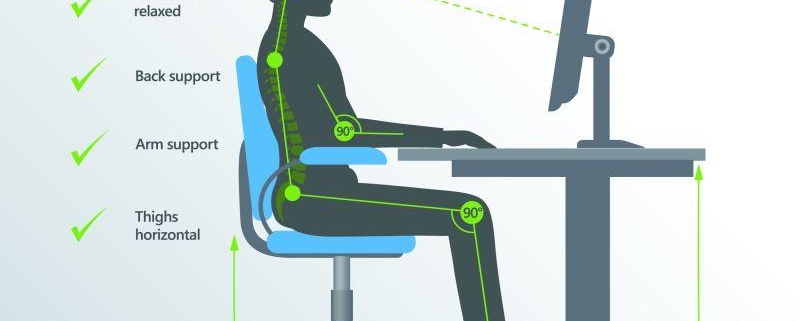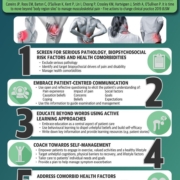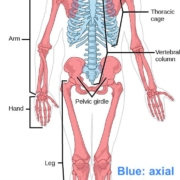5 Simple Strategies to Enhance Your Desk Posture Today
In today’s fast-paced world, where our desks have become a second home, maintaining proper posture is more crucial than ever. Poor desk posture can lead to discomfort, fatigue, and long-term health issues, making it essential to prioritize how we sit and work. In this listicle, we’ll explore five simple strategies that you can implement today to enhance your desk posture and promote overall well-being. From ergonomic adjustments to mindful habits, these practical tips will empower you to create a workspace that supports both productivity and health. Get ready to transform your daily routine and discover how small changes can make a big difference in your comfort and efficiency!
1) Invest in an Ergonomic Chair: Choosing a chair that supports your lower back and promotes a natural spine alignment can make a world of difference. Look for adjustable features that allow you to customize the height, armrests, and lumbar support to fit your body perfectly
Investing in an ergonomic chair is one of the most impactful changes you can make for your workspace. A well-designed chair not only cradles your lower back but also encourages a natural alignment of your spine, preventing discomfort during long hours of sitting. When selecting your chair, consider features such as:
- Adjustable Height: Ensure your feet rest flat on the floor or on a footrest.
- Armrests: Look for adjustable armrests that allow your shoulders to relax.
- Lumbar Support: Opt for a chair that provides support to the curve of your lower back.
- Seat Depth: Choose a chair that allows you to sit back comfortably while maintaining a few inches of space between the back of your knees and the seat.
To help you visualize the ideal ergonomic chair features, here’s a simple comparison table:
| Feature | Importance | Benefits |
|---|---|---|
| Adjustable Height | Critical | Promotes proper feet positioning. |
| Adjustable Armrests | Important | Reduces shoulder strain. |
| Lumbar Support | Essential | Supports lower back health. |
| Seat Depth Adjustment | Beneficial | Enhances overall comfort. |
By prioritizing these features, you can create a personalized seating experience that not only enhances your comfort but also boosts your productivity. Remember, the right chair is an investment in your health and well-being, making long work hours more manageable and enjoyable.
2) Adjust Your Monitor Height: Position your computer screen at eye level to avoid straining your neck. A simple way to achieve this is by using a monitor riser or stacking a few books beneath your monitor. This small adjustment can help reduce discomfort and improve your overall posture
Finding the right monitor height can be a game-changer for your comfort and productivity. When your screen is positioned at eye level, it minimizes the strain on your neck and shoulders, allowing you to maintain a more natural posture. To achieve this ideal setup, consider using a monitor riser or even a stack of sturdy books. This simple yet effective adjustment can make a significant difference in your daily work routine.
Here are a few tips to ensure your monitor is perfectly positioned:
- Eye Level: Your eyes should be in line with the top of the screen.
- Distance: Keep the monitor about an arm’s length away to avoid eye strain.
- Angle: Tilt the screen slightly back (about 20 degrees) for optimal viewing.
By taking these small steps, you can create a workspace that not only feels better but also enhances your focus and efficiency. Remember, a well-adjusted monitor is a crucial component of a healthy desk setup!
3) Practice the 20-20-20 Rule: To combat the effects of prolonged sitting and screen time, remember the 20-20-20 rule. Every 20 minutes, take a 20-second break to look at something 20 feet away. This not only helps reduce eye strain but also encourages you to shift your body position and stretch
In the digital age, we often find ourselves glued to our screens, which can lead to discomfort and strain. To counteract this, the 20-20-20 rule serves as a simple yet effective remedy. By adhering to this guideline, you can give your eyes a much-needed break every 20 minutes. Take a moment to look at something at least 20 feet away for 20 seconds. This brief pause not only alleviates eye strain but also promotes better focus and productivity. It’s a small commitment that can yield significant benefits for your overall well-being.
Incorporating this practice into your daily routine can also encourage you to shift your body position and incorporate some gentle stretching. Consider setting a timer or using an app to remind you when it’s time to take a break. During these 20 seconds, you might also:
- Stretch your arms and legs to relieve tension.
- Take a few deep breaths to refresh your mind.
- Change your seating position to promote better posture.
By making a conscious effort to follow the 20-20-20 rule, you not only protect your vision but also create a more dynamic workspace that encourages movement and reduces the risks associated with prolonged sitting.
4) Keep Your Feet Flat: Ensure your feet are flat on the floor or on a footrest when seated. This position helps distribute your weight evenly and promotes better circulation. If your chair is too high, consider using a footrest to maintain this essential posture
Maintaining a flat-footed position while seated is crucial for your overall comfort and health. When your feet are firmly planted on the floor or on a footrest, it helps to create a stable base that supports your spine and reduces strain on your lower back. This alignment not only enhances your posture but also aids in distributing your body weight evenly, which can alleviate pressure points that often lead to discomfort during long hours at your desk. Remember, the goal is to keep your knees at a right angle and your feet fully supported.
If your chair is too high, a footrest can be a game-changer. Here are some benefits of using a footrest:
- Improved Circulation: Elevating your feet slightly can help promote blood flow.
- Reduced Fatigue: A footrest can help reduce the strain on your legs and lower back.
- Enhanced Stability: It provides a stable platform, allowing you to shift your weight comfortably.
Investing in an adjustable footrest can also allow you to customize your seating arrangement to fit your unique body dimensions. With the right setup, you can create a more ergonomic workspace that encourages productivity and well-being.
5) Incorporate Micro-Movements: Throughout your workday, introduce small movements such as shoulder rolls, neck stretches, or wrist rotations. These micro-movements can relieve tension, improve circulation, and remind you to maintain an active posture instead of staying stagnant for long periods
Incorporating micro-movements into your workday can be a game changer for your posture and overall well-being. These small actions not only help to relieve tension but also serve as gentle reminders to keep your body active. Consider integrating the following movements into your daily routine:
- Shoulder Rolls: Gently roll your shoulders forward and backward to release tension in your upper back.
- Neck Stretches: Tilt your head side to side and forward to stretch the neck muscles, reducing stiffness.
- Wrist Rotations: Rotate your wrists in both directions to prevent strain from typing.
- Hip Shifts: While seated, shift your hips from side to side to engage your core and improve lower back support.
- Toe Taps: While seated, tap your toes on the ground to stimulate circulation in your legs.
To help you remember these essential movements, consider setting a timer to remind yourself to take a micro-movement break every hour. A simple chart can serve as a visual cue:
| Time | Movement |
|---|---|
| Hourly | Shoulder Rolls |
| Every 2 hours | Neck Stretches |
| Every 30 minutes | Wrist Rotations |
By consistently incorporating these micro-movements, you’ll not only enhance your posture but also foster a more dynamic and health-conscious work environment. Embrace these simple practices and feel the difference they make in your day-to-day activities.
In Conclusion
As we wrap up our exploration of these five simple strategies to enhance your desk posture, remember that small adjustments can lead to significant improvements in your overall well-being. Whether it’s investing in an ergonomic chair, practicing mindful breaks, or simply being aware of your body’s alignment, each step you take contributes to a healthier work environment.
Incorporating these tips into your daily routine not only helps prevent discomfort and fatigue but also boosts your productivity and focus. So, why wait? Start today, and give your body the support it deserves. Your desk may be your workspace, but it can also be a place of comfort and creativity. Here’s to a more balanced and enjoyable workday!










Leave a Reply
Want to join the discussion?Feel free to contribute!